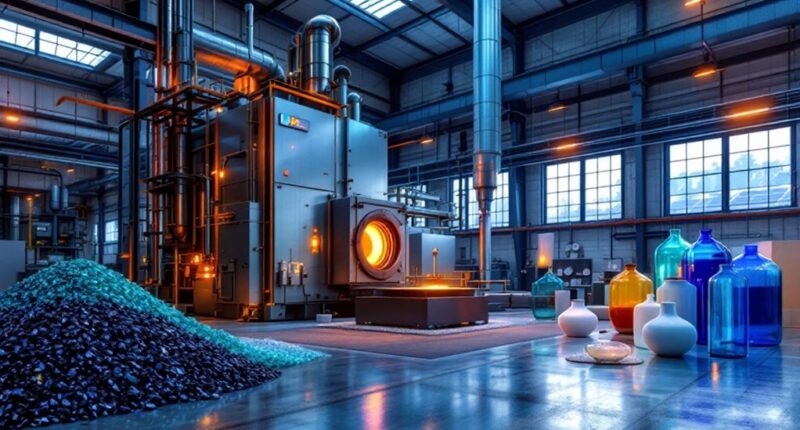The ceramics and glass industry is cleaning up its act through smart energy solutions. Recycled glass cuts virgin material needs by 95%, while electric melting slashes CO2 emissions by 80%. One-time firing processes and advanced kiln designs optimize energy use in ceramics. Renewable power, hybrid furnaces, and waste heat recovery systems are transforming these traditionally energy-hungry sectors. These innovations prove sustainability doesn’t sacrifice quality—just carbon footprints. The journey toward greener production methods has only just begun.

Innovation is reshaping the traditionally energy-intensive worlds of ceramics and glass manufacturing. For centuries, these industries have relied on furnaces that gulp energy like teenagers raid refrigerators, but today’s manufacturers are coming up with clever solutions that maintain quality while dialing down the thermostat on our planet.
Centuries-old industries find their green groove, proving even the hottest furnaces can cool their carbon footprint.
Recycled glass is becoming the industry’s golden child, reducing virgin material demand by up to 95% and proving that yesterday’s bottles make excellent tomorrow’s windows. It’s like glass is playing an infinite game of reincarnation, coming back again and again without losing its sparkle. Meanwhile, local sourcing guarantees materials don’t rack up more travel miles than a jet-setting celebrity.
Electric melting technology is transforming glass production, slashing CO2 emissions by up to 80% compared to traditional methods. Hybrid furnaces combine the best of both worlds – like a mullet haircut, but actually effective. O-I’s 70% electric furnace achieved a 43% CO2 reduction, proving that sometimes you can have your glass and heat it too. Advances like Verallia’s state-of-the-art facility showcase the largest electric furnace in the glass packaging industry, setting new standards for sustainable production.
Alternative cement formulations are cementing their place in sustainable construction. Geopolymers use industrial waste as raw material – fundamentally turning trash into treasure. These alkali-activated materials don’t just reduce environmental impact; they often outperform their traditional counterparts, like the nerdy kid who unexpectedly dominates the basketball court.
One-time firing processes are revolutionizing ceramics production, conserving energy like a squirrel hoards nuts for winter. Advanced kiln designs distribute heat more effectively than a perfectly toasted marshmallow, while waste heat recovery systems guarantee no BTU gets left behind. The integration of renewable energy sources for kiln firing represents a significant step toward reducing the industry’s dependence on fossil fuels.
The ceramic industry currently accounts for about 8% of industrial CO2 emissions – a statistic manufacturers are working to chip away at faster than a potter trims excess clay. By incorporating strategies like lightweight designs, modular construction, and water recycling systems, these industries are proving that sustainability doesn’t mean sacrificing quality or profitability – just reimagining how things have always been done.
Frequently Asked Questions
How Do Traditional Ceramic Firing Techniques Compare to Modern Sustainable Methods?
Traditional ceramic firing techniques are energy gluttons, consuming up to 70% of production costs with temperatures reaching a blistering 2,500°F. They’re notorious for uneven heating and greenhouse gas emissions.
Modern sustainable methods, by contrast, cut energy use by up to 50% through efficient kilns, temperature mapping, and innovative techniques like raw glazing and one-time firing. These newer approaches reduce carbon footprints by 20% or more while maintaining product quality—proving that pottery doesn’t have to cost the earth.
What Recyclable Alternatives Exist for Ceramic Glazes?
Several eco-friendly glaze alternatives exist for ceramists seeking sustainable options. Plant-based ash glazes utilize locally collected vegetation, creating unique finishes based on each plant’s chemical composition. Recycled glass can be crushed and incorporated into base glazes, producing crystalline effects and interesting textures.
Reclaimed clay and glaze waste can be crushed and reused as additives or decorative elements. Non-toxic natural alternatives provide lead-free options that remain vibrant while ensuring safety for functional pottery.
Can Solar Energy Effectively Power Glass Production Facilities?
Solar energy can indeed effectively power glass production facilities, as demonstrated by the Ardagh Glass plant in Madera, California. Their 13 MW solar project supplies 20% of the facility’s energy needs across a 55-acre solar field.
While glass manufacturing remains energy-intensive, projects like this show solar’s viability in the industry. Companies like NSG Group and Solarcycle are further investing in solar glass production, suggesting the technology is increasingly economical and practical for modern glass manufacturing.
Are There Biodegradable Substitutes for Conventional Ceramic Materials?
Several biodegradable alternatives to traditional ceramics exist, though they come with limitations. Options include epoxy-based materials reinforced with natural fibers, rice husk and corn stalk mixtures, starch-based composites, and mycelium-derived materials.
For finishes, plant-based glazes and biodegradable polymer coatings offer eco-friendly alternatives. These substitutes generally sacrifice heat resistance and durability compared to conventional ceramics, and many remain in developmental stages with higher production costs and limited applications.
How Much Can Carbon Emissions Decrease With Sustainable Glass Production?
Sustainable glass production could substantially decrease carbon emissions across the industry. Implementation of recycled glass can reduce CO2 by up to 20%, with each 10% of recycled content cutting emissions by 5%.
Electric melting and hybrid furnaces have demonstrated 43-50% emission reductions. Technologies like oxy-fuel can decrease energy consumption by 20%, while innovative approaches such as green hydrogen could eliminate 15,000 tonnes of carbon annually. Overall, thorough sustainable practices could potentially halve the industry’s current 86 million ton CO2 footprint.









